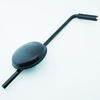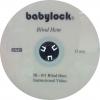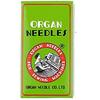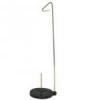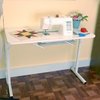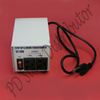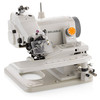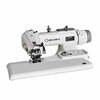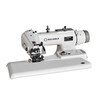*Consider Adding Optional Organ Box of 50 LWx6T 29-34 Curved, Assorted 5 Sizes of Needles, Portable Blind Hem Stitch Machines: Tacsew, Reliable, US StitchLine, Yamata, Gemsy, Rex, Tony, & Huei Hwang Manufacturer. Must be selected from Recommended Accessories Below.
For sewing all types of light to medium-weight materials including synthetics, knits and woolens. Typical sewing operations include pant cuffs, felling slack bottoms, hemming dresses, skirt and coat bottoms, light to medium (not heavy) draperies, negligees, undergarments, lapel padding, blouses and sleeves. Suitable for felling operations requiring a skip stitch to simulate hand stitching. Ideal for alteration rooms, clothing rentals, dry cleaners, department stores, dressmakers and home use.
- Single Thread
- Chainstitch Blindstitch
- With Swing-Down Cylinder Arm
- Swing Plate
- Skip And Non-Skip Stitch Lever
- Adjustable Thread Tension
- 1 To 1 Non-Skip Stitch And
- 2 To 1 Skip Stitch
- Portable Home Use Sewing Machines for Apparel Tailoring and Alterations only
Applications:
- Ideal for alteration rooms, tailors, clothing rentals, dry cleaners, department stores, dressmakers and home use
- Perfect for sewing all weights of materials including synthetics, woolens, cottons, fabrics and knits
- 1-to-1 Non-Skip Stitches: typical operations include felling edge tapes, bottoms of trousers, cuffs, wigging in sleeves, facings to canvas and knit goods, turned-up bottoms of fully lined coats, padding collars and lapels, and reinforcing trouser seats
- 2-to-1 Skip Stitch: for hemming dresses, skirts, slacks, trousers, sportswear, ladies coats, draperies, blouses and other articles
- Suitable for felling operations requiring a skip stitch to simulate hand-stitching
- 2-to-1 skip stitch is recommended for synthetics and other lightweight materials and 1-to-1 for heavier cotton, woolen and linen goods
Please note: Base color of this unit may vary
- US Warranty 90 Days labor on defects in materials and workmanship.
- Non-US Warranty: 30 days parts and labor
Stitch Length, Max.: 3-1/2 SPI Stitches Per Inch (7mm)
Curved Single Needle: LWX 6T
Looper: 4039, 471
Cylinder Diameter: 1-5/8 (40mm)
Work Space: Needle to Arm 4" (100mm)
Speed, Max (S.P.M.): 1000
Stitch Type: 103
- Stitch penetration and stitch length variability give you big-machine features in a light-weight, compact, and fully portable unit
- Heavy-duty motor and rheostat speed control
- Swing down cylinder arm allows for easy in and out of heaviest materials
- Swing away work plate
- Used for sewing all types of light to medium-weight materials including synthetics, knits and woolens
- Typical sewing operations include pant cuffs, felling slack bottoms, hemming dresses, skirt and coat bottoms, draperies, negligees, undergarments, lapel padding, blouses and sleeves
- Suitable for felling operations requiring a skip stitch to simulate hand stitching
- Ideal for alteration rooms, clothing rentals, dry cleaners, department stores, dressmakers, and home use
Click HERE for Short Generic Instruction Book Operating Manual User Guide for Table Top Portable Blindstitch Sewing Machines
Click HERE for Longer Generic Instruction Book Operating Manual User Guide for Table Top Portable Blindstitch Sewing Machines
Blind Hemmer Ending Stitch Techniques I show how I now end my blind hemmer stitches. In the past I always used the old technique of raising the needle to its' highest position and releasing the pressure foot and jerking the fabric back quickly to break the thread. This led to size 10 needles skipping stitches sooner than I thought they should. I contacted the mfg of my machine and they told me to use the technique I show in this video. Since I've gone to it my #10 needles are lasting much longer. :) The machine shown is an Industrial Consew made in Japan back in the 1970s. Kevin Sews Published on Jul 2, 2014
- Instruction Book
- Lubricating Oil
- Needles
- Table Clamp Bracket
- Tweezers to thread needle
- Knee Lift Assembly
- Thread Stand Assembly
- Regular wrench and allen wrench
- Foot Control
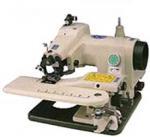 Consew 75T Blindstitch Blind Hem Chain Stitch Hemmer Machine
Consew 75T Blindstitch Blind Hem Chain Stitch Hemmer Machine
 stitch sample
stitch sample
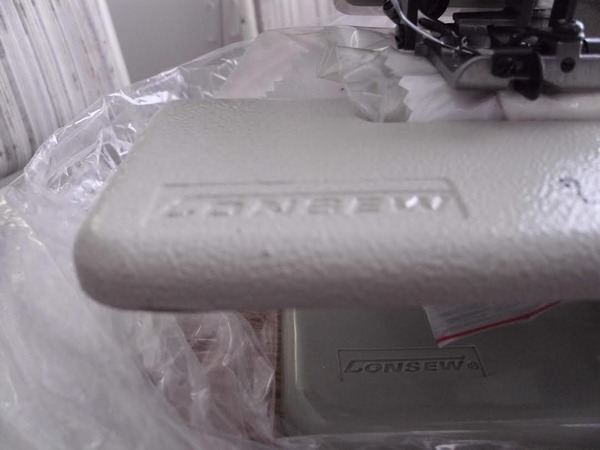 flat bed swing arm for access to cylinder arm for cuffs, sleeves, etc.
flat bed swing arm for access to cylinder arm for cuffs, sleeves, etc.
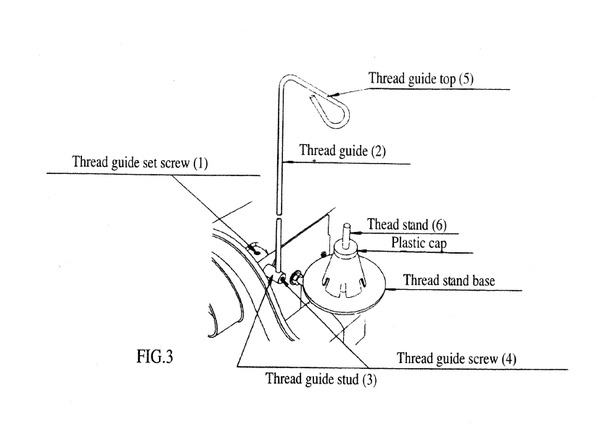 You have to put the thread guide (comes in the accessories) on the machine to guide the thread.
Tighten Screw (1) before tightening Screw (4) in the diagram.
You have to put the thread guide (comes in the accessories) on the machine to guide the thread.
Tighten Screw (1) before tightening Screw (4) in the diagram.
Janet, See 2. Fig 7 under Lubrication on the instruction book links on this page. One or two drops of sewing machine oil into the holes on top of the machine as shown on the second link.. There is no oil reservoir, only oil holes. You can also remove the side and bottom covers for more extensive lubrication of metal to metal moving parts. Hope this helps. Let me know if you have any questions about lubrication. John
Re: Single Thread Portable or Power Stand BlindStitch Hemming Machines:
When I pull the stitching out, several stitches unravel along with it. Is there a way to tack the stitches to prevent unraveling?
Jenna, there are several ways of securing a blind hem stitch at the end of a seam. The easiest way is to sew over and beyond the end of a seam, especially if hemming a tubular item like pants. When you sew over previous stitching it helps to lock the stitches in.
Before you remove fabric from the end of the machine feeder, turn the hand wheel clockwise to swing the needle all the way to the left position in the needle channel which will help secure the thread and stitch in place. Then quickly pull or jerk the fabric hem from behind the feeder which will break the thread and tie off the chain stitch so that it will not continue to unravel. It takes some practice because you may have to use the knee lever or hand wheel to position or release the fabric if it is not already at the end of the feeder.
You can also turn the hand wheel counterclockwise at the end of the seam (like reverse stitching but no formation) just to hide the end stitches, or you can manually weave the unraveled thread back into the chainstitch with a seaming needle.
Help!
I am breaking a lot of needles and the tension is getting too tight on its own while stitching and causing the thread to break. I am learning the machine for two weeks. Is it so sensitive too wools, cottons, and fleece that this would make such a major difference in the stitching - breaking needles, breaking thread? Kay
It may not be tension that is causing the problem with your portable blindstitch. If you have broken needles it has probably left some needle burrs in the thread and needle path that need polishing off with fine emory cloth (crocus) before sewing again.
Start with a new LWx6T needle without thread or fabric. Watch the needle as you turn the hand wheel. If there is needle deflection, reduce the penetration dial until there is no needle movement. If there is needle deflection caused by burrs, they must be polished off. Check the looper tip and two arms for any needle burrs and polish off. If there is needle deflection caused by the needle track lifting the needle, lower the track very slightly with the screws on the side of the black metal bracket above the needle.
Finally, Back off on the tension dial and retighten while you are sewing with a light strong thread and light to medium weight fabric, until you get the correct tension without loops. If tension is too tight it will push the thread up so it is not all the way down between the tension discs where it belongs. JMD
I use a blind stitch machine every day, I can not get this machine to work. I do not like the the (foot) control, I never got it to work. Their is no light, I can not see to thread the needle. I do not like the curve neddle. Betty.
Betty, I suspect you are having some difficulty with speed control and threading on your Consew 75T blindstitcher. So before you send it back for service and return, oil the internal metal to metal moving parts including the motor shaft between the motor pulley and motor housing. Remove the belt, and run the motor full speed for several minutes. Reinstall the belt and run the machine full speed without thread or fabric for several minutes. That should loosen it up to get better variable speed control from the foot control. In threading the needle you can use the needle threader that came with the machine or we can send you one. I use tweezers to insert the cut end of thread under the needle until I can grab the thread end coming up through the needle eye. Then fold a double hem, insert it to the right of the adjustable guide past the needle and under the top feeder dog. Then turn the hand wheel clockwise to check stitch formation, alignment of hem to guide, and tension. We can do this for you and set it up to hem on your fabric sample if you send it to us. Please advise.
Very satisfied with the ease of ordering and speed of shipment, especially so close to Christmas. Product arrived just in time!!!
Penny W, Hopkinsville KY
I have always sewed on industrial blind stitch. This machine amazed me on quality and ease of using and operating. I would recommend this blind stitch.
Pamela M, El Dorado TRINIDAD
Mr. John, Thank You for your reply yesterday with the steps to take to do the adjustments. I am very pleased and excited to inform you that I followed what you said to do and it worked. Yes it did take several adjustments and patience but it was worth it. I am just so happy that I did not have to return it to you. Have a safe and Blessed weekend.Best Regards, Pamela.
Henry, California
Consew 75T Portable Blind Hem Stitch Hemmer Machine is very portable to use and very helpful, The company is very good service. Thank you for your business.
W. Lewis, Montana
The instructions leave a little to be discovered. I did try and get the old oil out. It is a bit industrial for me. I practiced on my new machine for about 30 minutes and got a good product. It was my first time using a hemmer. I think the consew is a good value. I recommend it to my sewing students as well. It must be said that the foot pedal does not have a lot of range. The machine either is stopped or going at a pretty good rate of speed. That is why practice is imperative.
Claudia, Kentucky
I am very satisfied with my service from Allbrands.com, and I highly recommend Allbrands.com to anyone who is shopping for things that your website offers.
Denzil, Jamaica, NY
There was an error made in delivery of my scissors. maybe that was UPS's fault? In any event your staff was good enough to call me and provide me with a follow up e-mail advising of status of resolution. That was reassuring. I have built real confidence in your service. Thank you and keep up the good work. I would be a lifetime customer with that kind of service.
Alan, Greensboro, NC
Excellent products so far. Your company is always the baseline we use in pricing products. Few have come in with a lower price. We also appreciate the quality of your product. It is rare to these days to feel you can rely on a companys reputation, so far you haven't disappointed us. I plan on making a major purchase next Christmas for my wife with one of your quilting products. So far you beat the competition hands down.
Elizebeth H, Winton NC
I am very pleased with my product and your customr service was very helpful.


